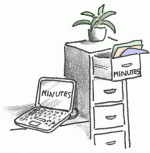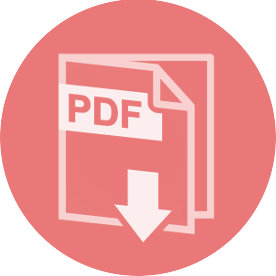
Listen to a recording of this guide
The minutes of a meeting are a basic record of important points that will be useful for the group to remember. For example, minutes could include the meeting date, names of people there, decisions reached and actions people said they would do.
Minute taking is often under-valued. However, it can make a massive difference to the effectiveness of your group's decision making! Creating good minutes doesn't need to be a daunting task. In fact, short, simple minutes are usually more useful than lots of detail.
Accurate, easy-to-read minutes can help by:
The core task during the meeting is to create a record that will be useful to the members of the group straight after the meeting and in the longer term future. This is a very important role! Feel empowered to ask people to pause at any moment while you catch up. In particular, think about:
Are you really clear what's being said and decided? Feel free to stop someone and clarify what they mean before you write it down! Even more importantly, check the wording of a decision before you record it.
Is the group making clear decisions? In an informal meeting, it is common for an idea to get raised, and then the discussion moves on, without checking agreement. Often, in this situation, some people will think the idea is going ahead, and other people will forget about it. A minute-taker can help by noticing when this happens, and checking whether it is agreed and should be written down.
Are your minutes representing people's points fairly? If you aren't very conscious of what you're writing, you may find you mainly record the points you agree with, or focus on the opinions of people who are dominant in the group.
A question to guide you here is 'What will be helpful to the group afterwards?' If you aren't sure, ask. This may be different for each agenda item, so don't hold back from checking several times in the same meeting! For example, on a simple issue you might only record what you decided, on a controversial topic you might include your reasons. Minutes often include:
Date: 12.02.2019
Present: Sam, Fatima, Deidre, Juan, Dimitri, Tracey (minute taker)
Good points: moving to Market Square helped - many more people spoke to us; several members of the public commented on banners and props - suggests visuals were effective.
Points for improvement: it takes a long time to fetch the stall stuff from whoever did it last, would be good to have it stored in town.
Decisions: Carry on having stall in Market Square. Investigate where we can store stuff in town.
Action point: Dimitri to call community centre to ask if they will store our stall materials. Deadline to feedback: next week's meeting.
Summary of discussion: There were concerns that creating leaflets 'by committee' can be time-consuming. At the same time, it was important to lots of people that the leaflet was 'right', we all want some input.
Decision: The leaflet should be created by a small working group (Tracey and Fatima volunteered). They should get guidance from the main group on key messages, audience, length and printing costs. Some people would like a chance to feedback on an early draft.
Action point: Working Group to contact printers to establish options and prices; come up with a suggested process for drafting leaflet (noting points raised in 'summary of discussion' above). Deadline next meeting.
Mon 19th February, 7pm, back room of Pedallers' Cafe. (NB: contact Juan for questions about the accessibility of the venue).
Making the minutes easy for everyone to use after the meeting is about as important as writing them down in the first place! If you won't have time for all these steps you could ask for someone else to finish off.
This may start with typing them up if they were hand-written. Check that they are easy to use, for example:
Language: use words that are simple and clear, rather than jargon, unexplained acronyms or academic words.
Layout: it should be simple to pick out the main points. Try using bold or a different colour for decisions and action points. Give each agenda item a clear header. Even better, word processing programmes enable you to create a contents table out of these headers, so information is easy to find. Some people will find particular fonts and styles easier to read than others, so check with the group if they have preferences.
Clarity: check if the minutes contain enough information to make sense. Add a short explanatory sentence, or add attachments (e.g. the groups' accounts) or web links where people can get more information.
Keep them short, even if this means deleting some bits! Reading the minutes should not be an outfacing task.
Other people at a meeting might have understood some details differently from you, so it's good to let them check what you've written. One option is to email the minutes straight after the meeting to people who attended, so they can check how accurate they are. This method has advantages over the traditional method of approving minutes at the start of the next meeting, because, straight after the meeting, the discussion is still fresh in people's minds. Also, checking minutes electronically means you don't have to use up time at the beginning of meetings.
It is good to circulate the agreed minutes to the whole group as quickly as possible - this encourages people to get on to their action points, and makes sure announcements get out while they are still relevant. Sometimes you might choose to use several methods, e.g. sending minutes via the internal email list, adding them to an online file-sharing platform (and posting them to anyone who doesn't have the internet!)
To stress the point again - your minutes are only useful if people read them! As well as having minutes that record what was said in each meeting, you might copy some items and store them in a way that is easier to refer to long term. For example, a single 'long term decisions' document could list any decisions you may want to check back on in the future. An ongoing action points document everyone can access could enable you to delete (or tick off) completed tasks. This way, action points from previous meetings are still visible if they haven't been done.
One option is to keep these documents somewhere secure on the internet (e.g. a file-sharing site with a log in). If you have a shared room or building, you might use files and noticeboards for storing 'hard' copies.
It is important that your minutes can be accessed by anyone in the group who needs to use the information. At the same time, you may need to be careful about confidentiality, data protection or group 'security' when circulating and storing minutes. For example, if you are part of a campaign group targeting a particular company, you might not want them to read what your strategy against them is!
You’ll also need to comply with data protection laws (GDPR). For more on this see: www.resourcecentre.org.uk/information/data-protection-for-community-groups/
